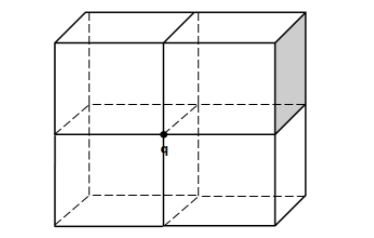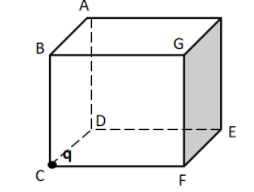
A point charge is placed at the corner of a cube. The electric flux through the shaded surface is

(A) $\dfrac{q}{{8{\varepsilon _0}}}$
(B) $\dfrac{q}{{{\varepsilon _0}}}$
(C) $\dfrac{q}{{24{\varepsilon _0}}}$
(D) $\dfrac{q}{{12{\varepsilon _0}}}$
Answer
219k+ views
Hint: To solve this question, we need to use the Gauss theorem. For that we need to place the charge symmetrically within a closed surface, which must be generated by using the similar cubes as given in the question. Then, using the unitary method, we can determine the required flux.
Complete step by step solution:
We know from the gauss theorem that the total flux passing through a closed surface, within which a charge is enclosed, is given by
$\varphi = \dfrac{q}{{{\varepsilon _0}}}$
In the figure given in the question, the charge is placed at the corner of the cube, not within the cube. So we need to enclose it within a closed surface, so that the Gauss theorem can be applied.
So we place three more cubes, similar to the one given in the question around the given charge, as shown in the figure below.

As we can clearly see in the above figure, that now also the charge is not enclosed. This is because the charge is kept at the outer surface of the cuboid, not within it. So we have to take a similar bigger cuboid and keep it on the outer surface of the cuboid, so that the charge is enclosed within the bigger cube thus formed.
As the charge is enclosed in the bigger cube, so the total flux passing through it is given by
$\varphi = \dfrac{q}{{{\varepsilon _0}}}$ …………………….(1)
Since the bigger cube is composed of two cuboids, and the charge is symmetrically placed with respect to both of them, so the flux passing through each of the cuboids is
$\varphi ' = \dfrac{\varphi }{2}$
From (1)
$\varphi ' = \dfrac{q}{{2{\varepsilon _0}}}$ ………………….(2)
So the flux passing through the cuboid shown in the above figure is equal to $\dfrac{q}{{2{\varepsilon _0}}}$.
Now, the cuboid is composed of eight cubes, and the charge is placed symmetrically with respect to all of them, so the flux passing through each of these four cubes is given by
$\varphi '' = \dfrac{{\varphi '}}{4}$
From (2)
$\varphi '' = \dfrac{1}{4} \times \dfrac{q}{{2{\varepsilon _0}}}$
$ \Rightarrow \varphi '' = \dfrac{q}{{8{\varepsilon _0}}}$ ………………...(3)
So the flux passing through the given cube is equal to $\dfrac{q}{{8{\varepsilon _0}}}$.
We know that a cube has a total of six faces. But the flux will not pass through each of these faces.

As can be seen in the above figure, the point charge placed at the corner C is touching the three faces of the cube, namely ABCD, CDEF, and BGFC. So the electric field through the charge will not be able to cut through these three faces. Therefore, the flux through all of these three faces will be equal to zero. Hence, the flux will pass through the rest of the three faces of the cube. Therefore, the flux passing through each of these three faces is given by
$\varphi ''' = \dfrac{{\varphi ''}}{3}$
From (3)
$\varphi ''' = \dfrac{1}{3} \times \dfrac{q}{{8{\varepsilon _0}}}$
$ \Rightarrow \varphi ''' = \dfrac{q}{{24{\varepsilon _0}}}$
The shaded region given in the question is nothing but a face of the cube. So the flux passing through the shaded region is equal to $\dfrac{q}{{24{\varepsilon _0}}}$.
Hence, the correct answer is option (C).
Note: We should not forget the fact that the flux passing through the surfaces, which the charge is touching, will be equal to zero. The electric field through the point charge will be parallel to these faces.
Complete step by step solution:
We know from the gauss theorem that the total flux passing through a closed surface, within which a charge is enclosed, is given by
$\varphi = \dfrac{q}{{{\varepsilon _0}}}$
In the figure given in the question, the charge is placed at the corner of the cube, not within the cube. So we need to enclose it within a closed surface, so that the Gauss theorem can be applied.
So we place three more cubes, similar to the one given in the question around the given charge, as shown in the figure below.

As we can clearly see in the above figure, that now also the charge is not enclosed. This is because the charge is kept at the outer surface of the cuboid, not within it. So we have to take a similar bigger cuboid and keep it on the outer surface of the cuboid, so that the charge is enclosed within the bigger cube thus formed.
As the charge is enclosed in the bigger cube, so the total flux passing through it is given by
$\varphi = \dfrac{q}{{{\varepsilon _0}}}$ …………………….(1)
Since the bigger cube is composed of two cuboids, and the charge is symmetrically placed with respect to both of them, so the flux passing through each of the cuboids is
$\varphi ' = \dfrac{\varphi }{2}$
From (1)
$\varphi ' = \dfrac{q}{{2{\varepsilon _0}}}$ ………………….(2)
So the flux passing through the cuboid shown in the above figure is equal to $\dfrac{q}{{2{\varepsilon _0}}}$.
Now, the cuboid is composed of eight cubes, and the charge is placed symmetrically with respect to all of them, so the flux passing through each of these four cubes is given by
$\varphi '' = \dfrac{{\varphi '}}{4}$
From (2)
$\varphi '' = \dfrac{1}{4} \times \dfrac{q}{{2{\varepsilon _0}}}$
$ \Rightarrow \varphi '' = \dfrac{q}{{8{\varepsilon _0}}}$ ………………...(3)
So the flux passing through the given cube is equal to $\dfrac{q}{{8{\varepsilon _0}}}$.
We know that a cube has a total of six faces. But the flux will not pass through each of these faces.

As can be seen in the above figure, the point charge placed at the corner C is touching the three faces of the cube, namely ABCD, CDEF, and BGFC. So the electric field through the charge will not be able to cut through these three faces. Therefore, the flux through all of these three faces will be equal to zero. Hence, the flux will pass through the rest of the three faces of the cube. Therefore, the flux passing through each of these three faces is given by
$\varphi ''' = \dfrac{{\varphi ''}}{3}$
From (3)
$\varphi ''' = \dfrac{1}{3} \times \dfrac{q}{{8{\varepsilon _0}}}$
$ \Rightarrow \varphi ''' = \dfrac{q}{{24{\varepsilon _0}}}$
The shaded region given in the question is nothing but a face of the cube. So the flux passing through the shaded region is equal to $\dfrac{q}{{24{\varepsilon _0}}}$.
Hence, the correct answer is option (C).
Note: We should not forget the fact that the flux passing through the surfaces, which the charge is touching, will be equal to zero. The electric field through the point charge will be parallel to these faces.
Recently Updated Pages
A square frame of side 10 cm and a long straight wire class 12 physics JEE_Main

The work done in slowly moving an electron of charge class 12 physics JEE_Main

Two identical charged spheres suspended from a common class 12 physics JEE_Main

According to Bohrs theory the timeaveraged magnetic class 12 physics JEE_Main

ill in the blanks Pure tungsten has A Low resistivity class 12 physics JEE_Main

The value of the resistor RS needed in the DC voltage class 12 physics JEE_Main

Trending doubts
JEE Main 2026: Application Form Open, Exam Dates, Syllabus, Eligibility & Question Papers

Understanding Uniform Acceleration in Physics

Derivation of Equation of Trajectory Explained for Students

Hybridisation in Chemistry – Concept, Types & Applications

Understanding the Angle of Deviation in a Prism

Understanding Collisions: Types and Examples for Students

Other Pages
JEE Advanced Marks vs Ranks 2025: Understanding Category-wise Qualifying Marks and Previous Year Cut-offs

Understanding Atomic Structure for Beginners

How to Convert a Galvanometer into an Ammeter or Voltmeter

Understanding Centrifugal Force in Physics

JEE Main Marking Scheme 2026- Paper-Wise Marks Distribution and Negative Marking Details

Degree of Dissociation: Meaning, Formula, Calculation & Uses




